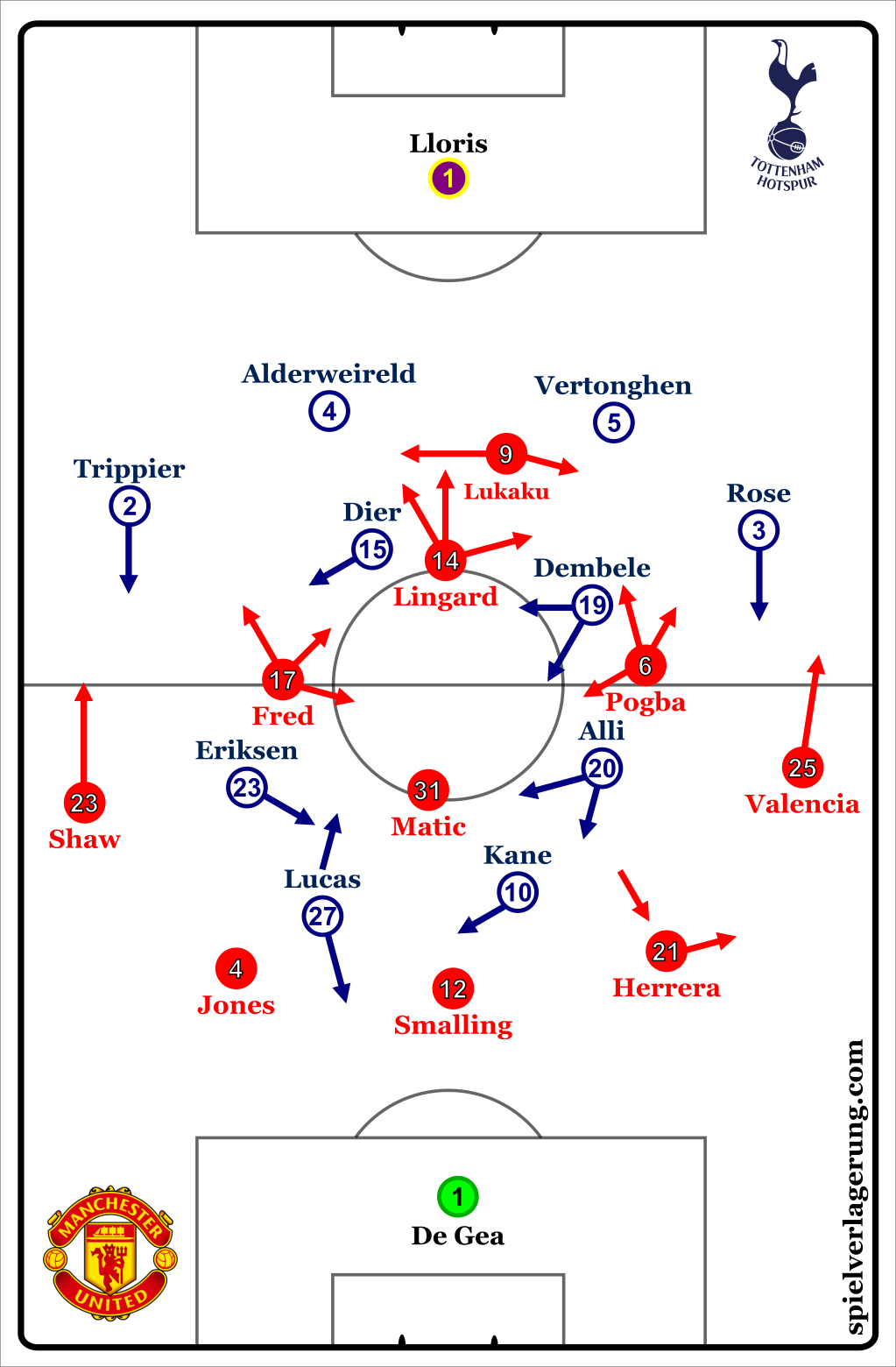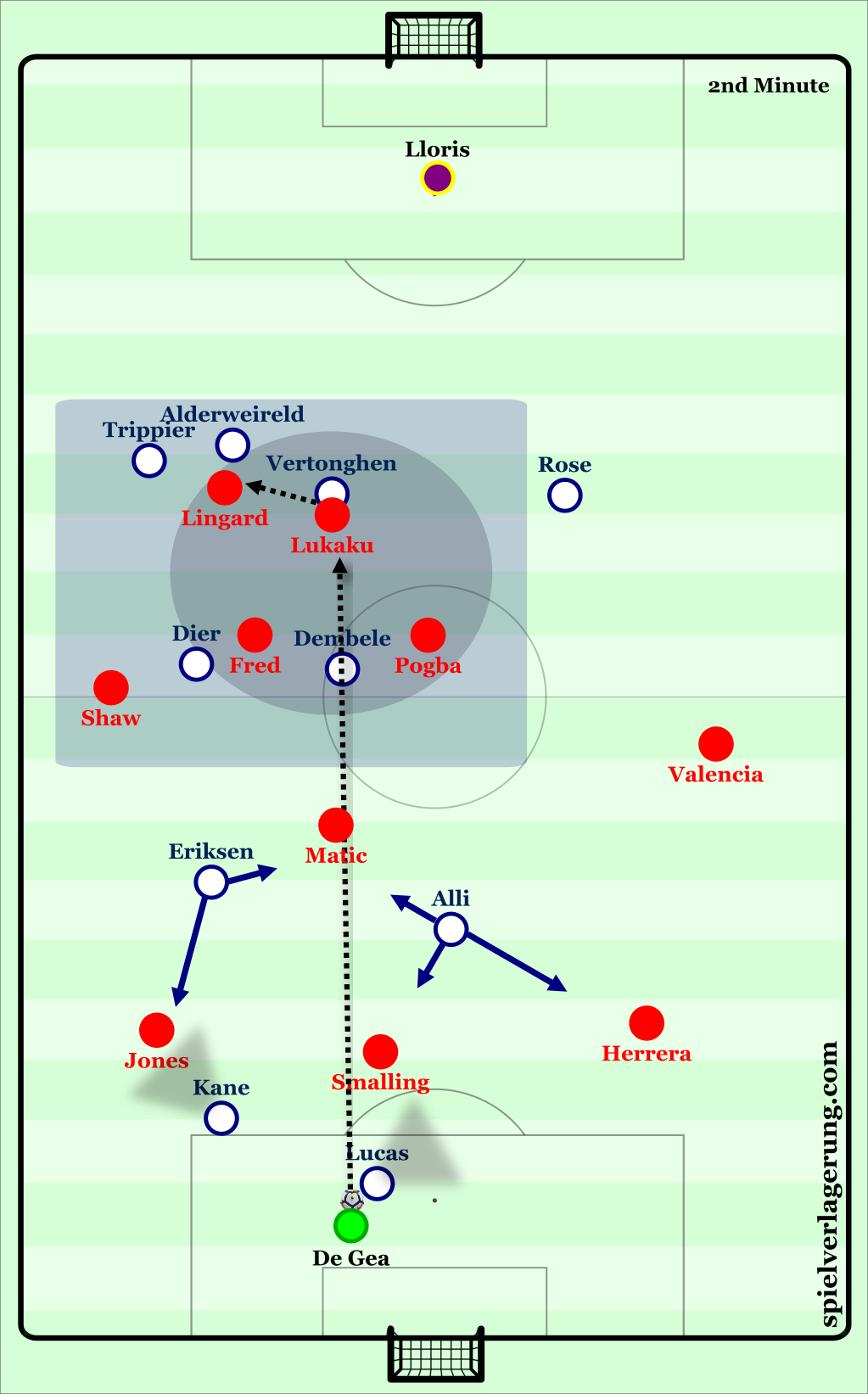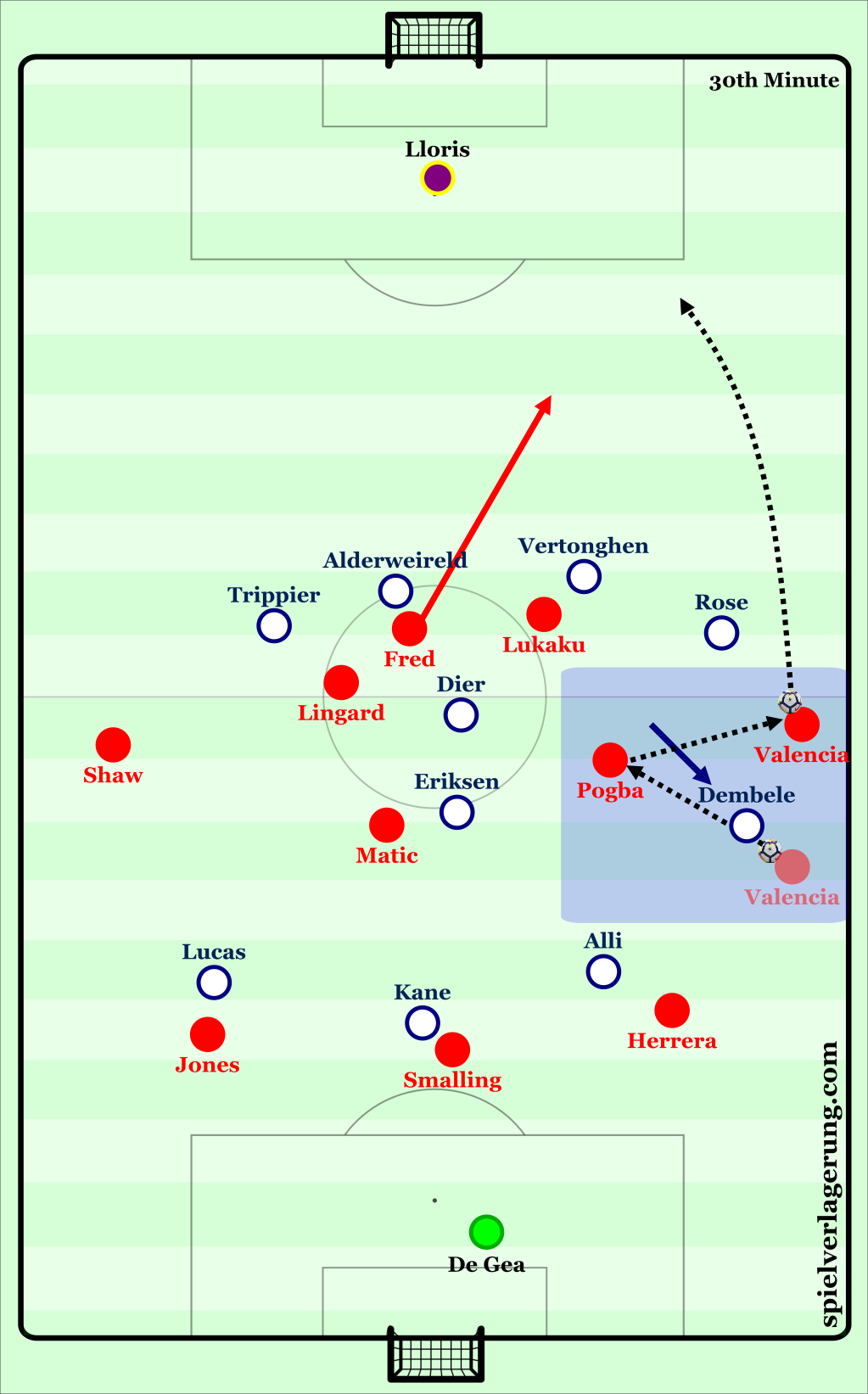Pochettino prevails over Mourinho
Mauricio Pochettino’s Tottenham continued their hot start in league play with a resounding away win over Manchester United. Despite the scoreline, Jose Mourinho’s solution to breaking through Spurs high pressure tilted the run of play in United’s favor for the first half before Tottenham scored.
Yet the change in game state in the second half showed other aspects with Mourinho’s team in possession that need improvement over the course of the season.
Each manager made a series of adaptations specific for this match. Starting with the visitors, Pochettino had his team starting in a 4-2-2-2 base, putting Lucas Moura upfront as he has since the beginning of the season. Dier and Dembele formed the deeper central midfield duo, alongside Trippier and Rose forming the outside back pairing.
The most prominent shifts came from Manchester United. Based on the team selection, some anticipated a 4-diamond-2, while there were murmurs of Matic being a third centre back. Instead it was Ander Herrera that completed the back three, moving to the right to permit Valencia and Shaw to move up the field. Matic acted as a pivot between Pogba and Fred, each given ample license to move forward to support Lukaku and Lingard. What resulted could be best described as a mix between a 3-1-4-1-1 and 3-4-2-1 for reasons outlined later.
Manchester United start bright through bypassing
Within Spurs base formation, their press did not deviate from the formation in a major fashion. Lucas with his speed was often the first player to pressure the ball, forcing the ball carrier toward Kane, who would often be just beneath him as cover ready to press the next pass. Eriksen and Alli each took up narrow starting positions, slightly leftward from central symmetry, but nonetheless using their blend of timing and athleticism to horizontally span the line behind the forwards for pressure on central players.
Between those four players, Spurs aimed to lure United into playing shorter passes toward Matic, then compacting toward him to press him and cut off subsequent supporting options. These pressing traps did come into fruition at points. However, not without precedent during his time at United, Jose Mourinho elected to have his team play direct to bypass Spurs pressure and avoid the threat of losing the ball close to goal.
With Mourinho’s system, Ander Herrera’s positioning as a right sideback not only bolstered early possession actions through his advantage in pressing resistance and ball retention over Smalling and Jones, but it also allowed for Valencia to occupy a higher starting position on the right flank since Herrera offered defensive coverage of the wing. Given the physical characteristics of the other midfielders, they could subsequently move into higher lines for bypassing the press through long balls.
Shorter passes out of the back were mainly used to as an intermediate to draw Tottenham’s front players toward the ball with United players getting into position as the ball was being circulated. Once Tottenham’s front players had committed to pressuring the ball close to goal, long balls would be directed to Lukaku via De Gea or the centre backs.
Lingard was present in the surrounding area of Lukaku hoping to win second balls or knockdowns with Fred and Pogba being supplemental players to recover possession as well. If the second ball was recovered, United either looked to play quick combinations through the centre to get in behind or recirculated possession to begin their attacking half build up. The right was generally favored in De Gea’s distribution, involving Pogba moreso than club newcomer Fred.

One example where United’s circulation in the back moves Spurs toward De Gea, who plays Lukaku to bypass Spurs. Around Lukaku are several players around to recover second balls.
Matic functioned as the main central presence between himself, Fred and Pogba. When the one member of advanced partnership moved forward, Matic would slide slightly toward that side with the far side central player tweaking his position to be slightly deeper if it was during consolidation of possession i the attacking half. If it was the initial long ball, the ball far central midfielder would move toward the centre to add more presence proximal to the ball. These pendulations of course were dependent on where the direct pass was played. Lukaku mainly occupied one of the halfspaces when these long balls were played into him, allowing United to both get more players around the ball and quickly initiate wing attacks.
Manchester United’s main mechanisms of attacking in their opponents half came from these wing attacks. Since Eriksen and Alli were too distant after the first ball up was played, United liberally took advantage of uncertainty within Tottenham about who was to step between the fullbacks and the central midfielders. As one of these players stepped, the wingbacks commonly played quick wall passes with interior players to progress up the pitch and dribble. In other moments, multiple players would join for wing combinations, creating some intricate three player sequences that were the product of players leaving their typical spots to join in.
Other successful ways of maneuvering toward goal for Manchester United came from attacking combination sequences that resulted from such heavy local occupation of the ball. Thanks to the individual qualities of the players mixed with well timed movements into depth from Lingard and Fred, United put together moments of predominantly one touch play that broke through the midfield of Spurs in a quick incisive manner.
From these wing methods of penetration came the main avenues of United’s chance creation. The wide areas originated the actions just prior to shots, which ranged from players receiving the ball to cut in toward goal to shoot, speculative crosses toward Lukaku, or well played cutbacks just in front of the Belgian Spurs centre backs. Despite having a lot of chances in terms of shot attempts, few of these genuinely challenged Lloris in the first half, with the location of the shots having a large part of that, oftentimes being at difficult angles or far distances with multiple players in front of the ball.
To simplify Mourinho’s general approach against Spur’s high pressure, he structured his team so that from playing long balls and pressuring the subsequent second balls to recover possession or force a give away, they were able to gain territory into Tottenham’s half to begin their attacking half build ups. Once this was established, the wing backs and combination play between them was integral in how United progressed toward goal, creating numerous chances, albeit lacking potency.
Perils of United’s Direct Play and Tottenham’s Responses
Despite United’s direct play being a force for them to advance up the pitch, there were some aspects of their play that foreshadowed where Spurs would ultimately hit United for could be described as a snatch and grab win by some.
First, because United pushed Fred and Pogba to help with aerial ball retention, United ended up having overstretched distances between the defense and midfield. This isn’t a major issue if they choose to go long every time. Yet, when the home side chose to build through midfield instead of go long, the overly high occupation prevented easy progression from Matic.
Spurs were able to trap the Serbian and place two or three midfielders around him to recover possession or force an error at the minimum. Left isolated, Matic is not the sort of player to evade these pressing situations gracefully, needing shorter options around the ball to support him and progress the attack.

When United opted to build short rather than play long, Matic was often trapped by Eriksen and Alli, with little useful options near him because of the heavy occupation of higher zones.
This heavy occupation of higher lines also placed high demands on Matic to cope with counter attacks when they came. If Lucas dropped into the line with Alli and Eriksen, Matic had to account for two, sometimes three players in 10 metre radius, calling upon defenders to assist him to step up and challenge these balls. If the ball is won, United can attack again, but if the dual is lost, than the fullbacks expose free spaces in behind to attack for Spurs. This was less common in the first half due to the flow of the match, yet the signs were there with some of the direct running sequences that ended in tactical fouls.
The second half brought a slight shift in the team shape for Pochettino’s side. Eriksen took a slightly deeper starting position in the right halfspace, Alli moving more centrally. Dembele advanced slightly from Dier’s clutch, but still was much deeper than the Dane. The shift theoretically provides more players to challenge second balls, whilst delegating Eriksen and Dembele to cope with the wing back combinations that posed Spurs so much trouble in the first half. From a countering perspective, Eriksen could also span the wing more, leaving Moura to do more running centrally and have Alli act as a late runner reacting to the spaces the striker tandem opens for him with their movements.
These shifts paid off excellently for Spurs, as Kane and Lucas quickly slotted two goals for their side, drastically changing the game state and the mindset of Manchester United’s approach.
Frenzied Finale
After conceding the two goals in quick succession just after the break, Manchester United made all of their changes over a period just under ten minutes. Ander Herrera left the match for Sanchez, with Lindelof and Fellaini coming in for like for like changes, with the end result being their typical 4-2-3-1 shape. Matic parted for the former Everton man, With two big Belgians up front now for receiving aerial passes, United had two options for long direct play to beat Spurs pressure. However, the change in the game state led Spurs to be more disciplined in their block and not be prone to being elongated by United’s early circulation.
Spurs’ tilted diamond in midfield secured the central areas and ensured that Fellaini had multiple players pressuring him once the passes came into his feet, leading to his usually influential knockdowns being snuffed out. Similar to the first half, this formation shift concedes space in the wing areas in favor of more players in the centre.
From United’s standpoint, their attacking tendencies did not evolve from the first half display. Some of the combination play to set up scoring chances that occurred in the first half vanished, with the introduction of Fellaini beaconing a seismic shift in how United creates opportunities and chances to become more direct. For the ultimate Plan B, United as a team abandoned some of their principles that led to them having more success in the first half upon his entrance.
Increased dynamism in the form of Sanchez helped with getting forward, but as Pogba and Fred chased for hope, large vertical gaps emerged between the two of them and the defensive line, creating favorable conditions for Alli, Kane, and Lucas Moura to break through for counter attacks and run towards goal. This urgency increase being a double edged sword saw Spurs take advantage of these risks, in the form of Lucas’ second goal to cap off a strong individual performance.
Conclusion and On Aerial Directness/Risk Management
Despite the promising start, Manchester United’s issues were not about the number of shots themselves and the flow of play, but the quality of the shots taken. There were a handful of chances that one could expect better execution from considering they are world class players, but the design of the team is supposed to counteract against these fluctuations, giving your team the best chance to win. From Pochettino’s perspective, his team were definitely fortunate to grab the first goal, but also intelligently designed to capitalize on the weakpoints of United’s transitioning defending and overzealous player tendencies of the midfielders in attack.
United’s attacking play when predicated on direct play becomes more reliant on randomness to fall in their favor. As aerial play is more technically difficult for players to control, plus the aspects of timing the ball to get particular outcomes while being challenged, getting the desired outcome is much more based on randomness than passes on the ground. Ground passes can reach their target more easily assuming the same time and space because of the larger surface area of one’s foot relative to the forehead and ease of controlling. This is just one aspect of why more dominant teams generally have more possession than their opponents.
For some teams, this randomness is favorable to them, since they lack the player quality to go toe to toe with top opposition and expect to win. Manchester United have strong enough players where such reliance on aerial chance is illogical given their individual superiorities. Long balls in themselves are not bad, they provide a good solution to many situations. However, very good teams just happen to use long balls less than not very good teams, since very good teams are better able to exercise control over their opponents, which is correlated with fewer long passes.
Jose Mourinho does not seek to solve problems, rather he avoids them. Until this shift takes place, United will consistently have fluctuating performance levels that seem like a coin flip whether they turn out good or poor.



1 Kommentar Alle anzeigen
TheTrooper August 30, 2018 um 2:40 pm
As always, spot on analysis, but what I think is lacking is context in why Mourinho has chosen this tactic. I think his team is still in preaseason, and though Spurs are maybe the only team in the league which had as many problems with players and almost non existent preseason, I think that if Mourinho chose to assert control with more short passing it would lead to a disaster. So I think it was more of a case of not avoiding problems, but surprising the opponent in a tactical way. And yes Mourinho often plays direct and long balls, but against Spurs there were so many tweaks that it turned out to be something quite different than expected, and it worked well, although it had the same tactical “foundation” in direct passing. And then again, yes, he has world class players, but using the likes of Lukaku and Fellaini later on and the pace of Fred and Lingard I think decreases the randomness of long balls considering Lukaku is a powerhouse when it comes to jumping. So in the end, there were some bad things in what Mou did, but I think it was the best available option, trying to control the game with more posession and shorter passing would make Spurs’ and their style of pressure at home and comfortable.